RAY
WESTLAKE
London - Part Two
|
Probably the only thing unchanged in London since the late 1950s when I first went out to work are the crowded rush-hour tube trains. Today people still pack themselves into the carriages like sardines, but now, in addition to reading their newspapers with outstretched arms, they managed to eat their breakfast and dress at the same time. I'm on the Circle and District line heading for Tower Hill and hope to visit several of the City's churches before making my way over to Hyde Park and the Serpentine. Anything in between will come as it comes.
Unable to stand the crush and the aftershave of the man next to me any longer, I get out at Cannon Street and enjoying the fresh air walk along into Eastcheap, up to Fenchurch Street and then Aldgate. But here I find St Botolph's closed, as is St Katherine Cree just down the road in Leadenhall Street and whose organ was once played upon by Purcell, Handel and Wesley. But I'm in luck at St Helen's, Bishopsgate where much has changed since major damaged to this and other City churches was caused by bombs in 1992 and 1993. Here, and they call it the 'City's Westminster Abbey', you will see wall-to-wall, floor-to-ceiling memorials, many of them taken in from redundant churches.
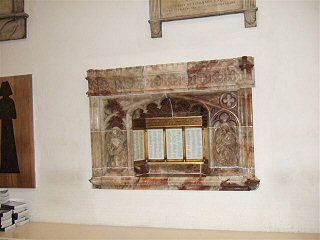
But only one of them is connected with the First World War. Set into a surround of Derbyshire alabaster and dating from 1921, is the parish memorial for St Helen's and St Martins (church pulled down in 1874) with its five panels mullioned in gold as if the panes of a semi-detached bay window. On these are record the names of those that 'gave their lives for England'.
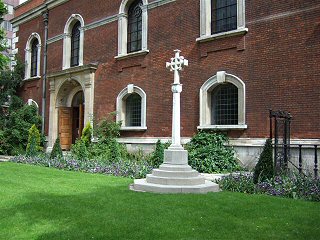 |
Making now for Liverpool Street Station, I stop off at St Botolph-without-Bishopsgate where in its grassy churchyard a tall white stone cross on an octagonal base remembers (south side) the officers and men of the Honourable Artillery Company 'who died in the Great War, Aug. 4, 1916'. Their Headquarters not far away at Armoury House, Finsbury. And if we make our way around the base of the cross we see that 'Our brave dead of Bishopsgate 1914-1916' are also commemorated (west side). |
All of them here in good company on the same cross along with (east side) Lord Kitchener, who died at sea on 5th June 1916 when the ship he was sailing in to Russia (HMS Hampshire) struck a German mine and (north side) John Travers Cornwall who at sixteen years old won the Victoria Cross at Jutland. He lived not to far away in Commercial Road, Stepney. But was this memorial actually erected during the war? Just look at those dates and also, if you have a copy, C.S. Cooper's book The Outdoor Monuments of London in which the St Botolph's cross is credited to Andrea Angel with a date of January 1917. Well, thanks to a printed Order of Service in the possession of the HAC Archives entitled 'Second Anniversary of the Great War, August 4th, 1916. Unveiling of Memorial Cross to Lord Kitchener by the Lord Mayor of London in the presence of the Hon. Artillery Company. Address by the Lord Bishop of Stepney', we have the answer and more.
| Inside now and on the north side of the church we see once again the name of that ancient London regiment, the Honourable Artillery Company whose chapel we are now in. Dedicated on 12th November, 1922 and rich in dark wood, here, behind ornate wrought-iron gates with gilt badges above, is a Book of Remembrance. And there are more badges over on the other side of the church where the men of the London Rifle Brigade are remembered. Their HQ also close by at 130 Bunhill Row. |  |
We saw reference to the 'Brave dead of Bishopsgate' out in the churchyard, but here also on the south side of the church we see their names. Fifty-eight in total all of them set out in two wood panels, one either side of a fine gilt-framed mosaic.

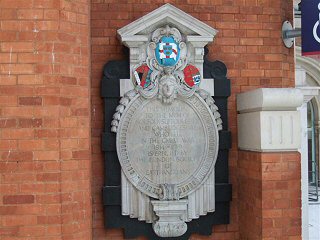 |
At Liverpool Street Station, red brick, opened in 1874 on the site of the old Bethlem Hospital and which now looks like a supermarket with railway terminus attached, I take note first of that grand tablet erected by the London Society of East Anglians to the men of Norfolk, Suffolk, Essex and Cambridgeshire. |
| Then, just around the corner in the main booking hall and high up on the wall, arched and flanked by wreathed columns, is the memorial to those of the Great Eastern Railway Company who 'in response to the call of their King and Country, sacrificed their lives'. Although this is a new site. For what we see here today once stood elsewhere in the station and during recent redevelopment of the terminus was re-built it its present position. Perhaps this though is obvious in as much as the lower section seems interfered with. What, I wonder, came first? Was it the lift or the memorial. Certainly, in my view anyway, no place for the former in the latter. Even with its matching white marble doors. | 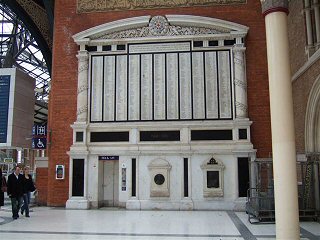 |
There in eleven panels are their names. More than a thousand of them, drivers, firemen, clerks, porters, carriage cleaners, men from the Marine dept and some from Goods. And I can tell you with more than average precision for me when this great memorial was unveiled. See that bronze bust in relief to the right. Well that's Field-Marshal Sir Henry Wilson who within two hours of his unveiling this memorial on Thursday 22nd June 1922 was assassinated by the IRA.
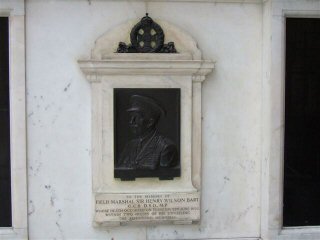
Look now back up to those lists of names and there, somewhere on the fourth column from the left is that of Charles Fryatt. That's him in the other bronze roundel. Captain of the Great Eastern Railway Company's steamer Brussels, he in utter defiance of the Germans continued to work the Rotterdam-British East Coast route after war was declared.
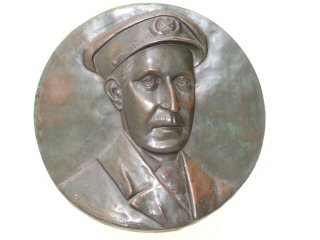
On two occasions in March 1915, though, the Brussels was attacked by U-Boats. The second attempt to sink the vessel seeing Captain Fryatt steer his ship towards the surfaced and torpedo-aiming-submarine forcing it to dive. 'You could have easily hung your hat on the periscope as she lay along side us', he later recalled. But on 23rd June 1916 a German patrol stopped the Brussels and its twice honoured (once by the GERC, once by the Admiralty) Master was taken first to Zeebrugge then on to Brugge where he was tried on 27th July for attempting to ram the U-Boat over a year previous. Although strongly denied by Captain Fryatt and the British Government - 'he was simply trying to avoid an attack and was only interested in saving the lives of his passengers and crew '- he was non-the-less found guilty and subsequently executed. Bearing the date 27th July 1917 (one year after his death) Captain Fryatt's bronze was dedicated by the Netherlands Section of the League of Neutral States. Be he one or the other, for more of this great hero see Martyr or Pirate? by Alan G. Jamieson, The Mariner's Mirror (Vol. 85, 1999).
 |
Making for the Guildhall, I almost miss the stone tablet set into the outside wall of St Lawrence Jewry next door and in memory of those of the 1st London Brigade, Royal Field Artillery who laid down their lives 1914-1918. From their Headquarters in not far off Handle Street, Bloomsbury, these Territorial Force gunners reached France in October, 1915 and saw service throughout the great Somme campaign and most subsequent actions on the Western Front. Then in the Guildhall itself, the present building dating from between 1411 and 1430 and where much food and wine is consumed at state banquets, I see just off of the Great Hall the war memorial. |
Set into the wall of the porch (it's called the 'Dance' porch) and, for the time being anyway, out of bounds to the general public. But a kind guide unlocks the strong iron gates and lets me in. Here are two bronze panels, one for each of the world wars. To the left, and surmounted by the City arms are the names of those lost 1914-1918. There's one name, a 'Councilman', then under 'Sons of Councilmen', a further twenty-nine. Staff come next and there are seventy-nine of them. Cast by the Bromsgrove Guild and designed by Sydney Perks, this tablet was unveiled by the Rt Hon Lord Mayor, James Roll, Esq, on 20th January 1921.
Unveiled on Thursday 2nd March 1922 was the hansom bronze group by F.V. Blunderstone that is the Prudential Assurance War Memorial. And how well the red granite of the pedestal and bronze of the figures and name panels blend in with the warm brickwork and terracotta of the company's building just along from Chancery Lane Station in Holborn (Alfred Waterhouse, 1879 and extended 1899-1900).
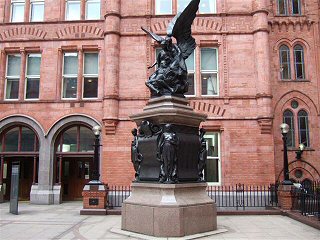
Here in a tidy courtyard-the site today is a few yards from the original if a photo taken at the unveiling is anything to go by-we see two winged figures supporting from behind a dead or wounded soldier. And around the pedestal more female figures are seen holding some item or other of war. One has a ship, another a howitzer, there's a shell and round the other side a bi-plane.
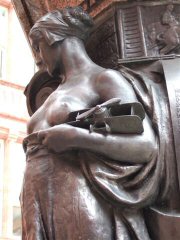
Here also in rich bronze are scenes of ships at sea and a gun team going into action, and here we see commemorated on three panels the 794 names of those connected with the Prudential that lost their lives.
| South of the river now I reach Waterloo Station where the main pedestrian entrance arch commemorates those railway employees that were killed. See their names set out in four panels as you walk up the stairs. But before I make my way over to Hyde Park via the Underground, less crowded and aftershaved at this time of day I hope, a quick look across the road to the Parish Church of St John the Evangelist. Built in 1824 to celebrate victory in the Napoleonic wars. |  |
See just outside to the left the Crucifix: 'Erected by the nursing staff in honour of the patients who died in the King George's Hospital, H.M. Stationary Office, Stamford Street, used as a military hospital during the war.' There names can be seen on a Roll of Honour inside the church, while those from the parish that died are inscribed on three sides of Crucifix base.
My notebook and camera put away for the time being, I reach the Serpentine in Hyde Park where the rest of the day is to be spent reliving childhood memories of trips to the 'Seps' with my mother and father. But now the war memorials are finding me. For there on the wall of the bathing pavilion (Lido), in which we changed for swimming, and from where each year those brave soles traditionally set out on Boxing Day to do the same in much colder water, I notice a plaque by the entrance 'In proud memory of Captain J.O. Cooper Royal Flying Corps killed in the Great War aged 20'. Killed in action while carrying out a bombing raid on Epéhy Station, France on 21st July 1916, from RFC Communiquésés 1915-1916 I note that six R.E.'s of 21 Sqn. were involved and fourteen 112-pound bombs were dropped. Two burst in the station and others on the line north of it and in the town. Jack Oliver Cooper was one of three pilots from that squadron to be posted as missing.
Enough seen on this chilly, but comfortable, day, I walk back to my hotel in Victoria via Prince Consort Road where from behind the closed windows of the Royal College of Music the voice of a young soprano can be heard high above the busy London traffic. Perhaps she too is twenty.
![]()
 Copyright © Ray Westlake June,
2006
Copyright © Ray Westlake June,
2006
Return to the War Memorials Contents Page
Return to the Hellfire Corner Contents Section